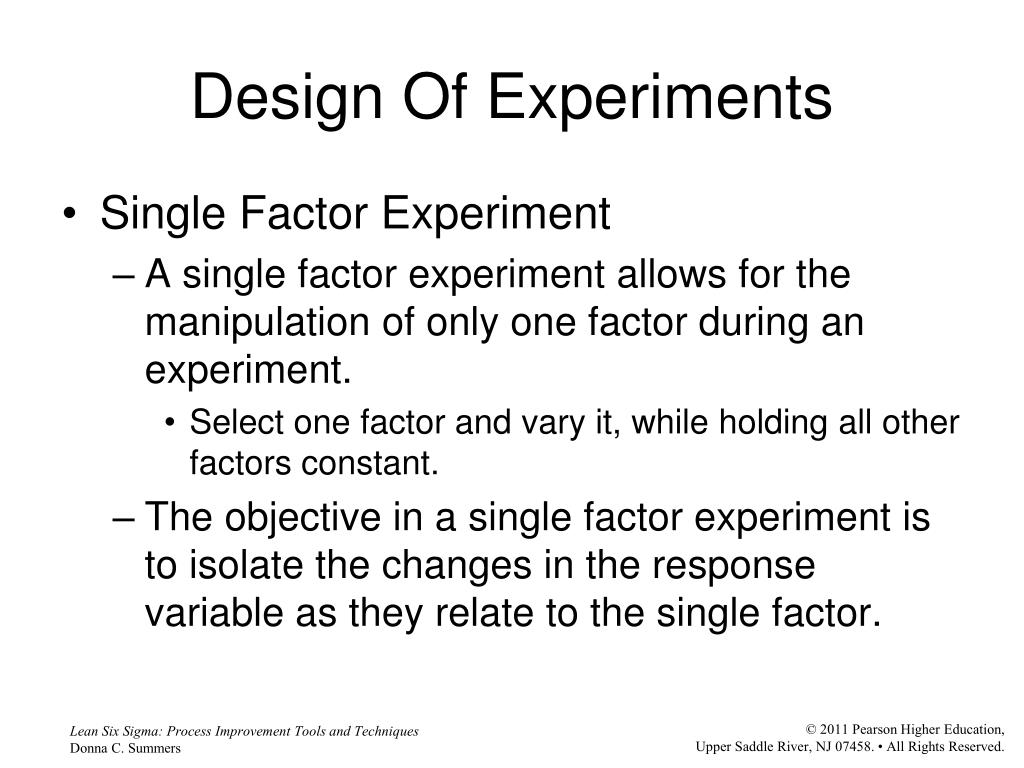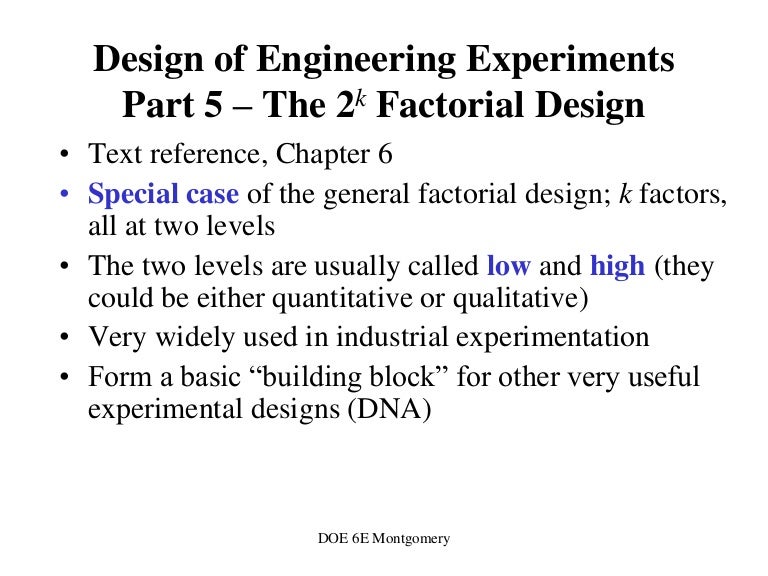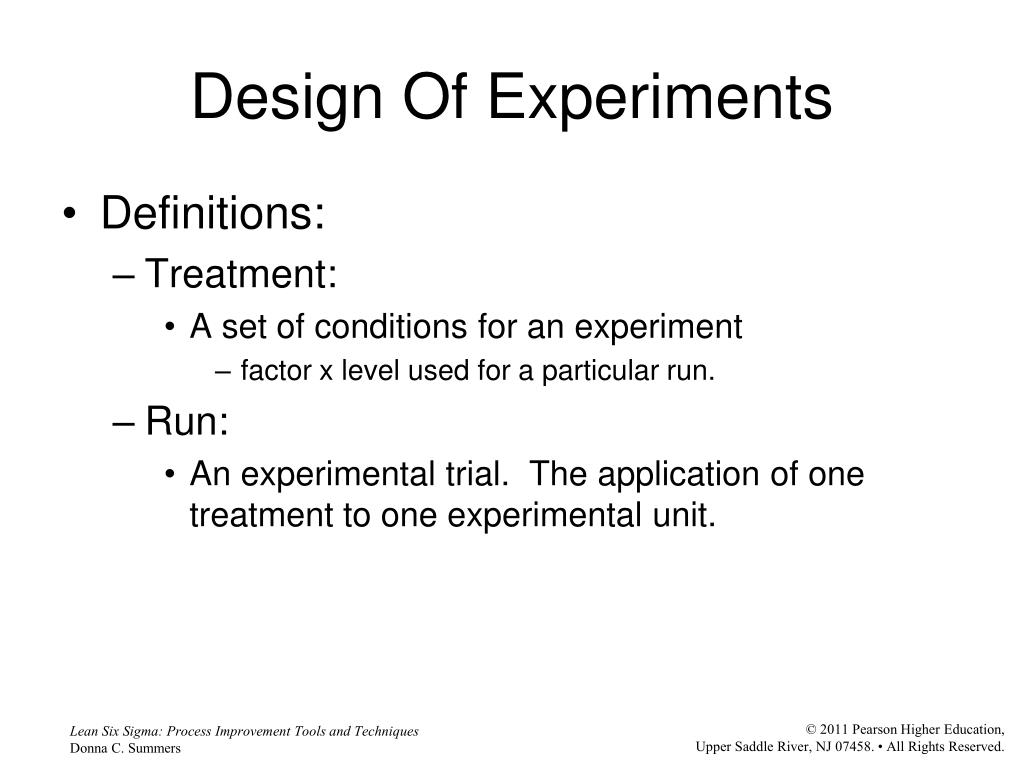Table Of Content

In 1950, Gertrude Mary Cox and William Gemmell Cochran published the book Experimental Designs, which became the major reference work on the design of experiments for statisticians for years afterwards. The variance of the estimate X1 of θ1 is σ2 if we use the first experiment. But if we use the second experiment, the variance of the estimate given above is σ2/8. Thus the second experiment gives us 8 times as much precision for the estimate of a single item, and estimates all items simultaneously, with the same precision. What the second experiment achieves with eight would require 64 weighings if the items are weighed separately.
What is DOE? Design of Experiments Basics for Beginners
Blinding involves keeping participants, researchers, or both unaware of which treatment group participants are in, in order to reduce the risk of bias in the results. Laboratory experiments are conducted under controlled conditions, which allows for greater precision and accuracy. However, because laboratory conditions are not always representative of real-world conditions, the results of these experiments may not be generalizable to the population at large. In this design, each participant is exposed to all of the different treatments or conditions, either in a random order or in a predetermined order. FMCG industry is a part of consumer goods industry that includes all the products which are sold to the general public by any means such as retail stores, internet or by phone.
A Quick Guide to Design Rigorous Machine Learning Experiments - Towards Data Science
A Quick Guide to Design Rigorous Machine Learning Experiments.
Posted: Wed, 08 Feb 2023 08:00:00 GMT [source]
Evaluate the effect of change/s
Design of Experiments is a framework that allows us to investigate the impact of multiple different factors—changed simultaneously—on an experimental process. A perfect cup of tea depends on multiple other factors, such as the blend, brewing time, and the addition of sugar. In other words, making a perfect cup of tea is complex and multidimensional. DOE allows researchers to investigate the effect of changing multiple factors simultaneously. Some knowledge of statistical tools and experimental planning is required to fully understand DOE methodology.
Applied Statistics: Data Analysis
It incorporates a lot of previous statistical and management techniques. All experiments are designed experiments, it is just that some are poorly designed and some are well-designed. Explore essential techniques in data transformations for normality to unlock true insights and enhance your statistical analysis. Discover the significance of effect size for chi square in data science, understand standard measures like Cramer’s V and Phi coefficient, and learn how to calculate them. Adjustments made based on the DoE findings significantly improved the consistency and strength of the welded joints.
When to use DOE?
Probably many factors, temperature and moisture, various ratios of ingredients, and presence or absence of many additives. Now, should one keep all the factors involved in the experiment at a constant level and just vary one to see what would happen? In a between-subjects design (also known as an independent measures design or classic ANOVA design), individuals receive only one of the possible levels of an experimental treatment. Based on this, you can fine-tune the experiment and use DOE to determine which combination of factors at specific levels gives the optimal balance of yield and taste. In a quasi-experimental design, the participants of the groups are not randomly assigned. This website is using a security service to protect itself from online attacks.
The responses we are looking for in this experiment are the yield, the weight, and the taste of the strawberries. Strawberries also need plenty of water to ensure juiciness; applying 1ml of water would be difficult to accurately achieve and, possibly, trigger drought stress responses. It’s a bit like trying to analyze the perfect cup of tea by ignoring the temperature of the water, brew time, and blend, and instead just focusing on whether you add the milk first or second. For example, it isn't possible to fully understand the functional consequences of changing a protein's structure without understanding all the contexts in which it appears. Its interactions within biological networks are what really define its function, so even minor changes can produce a plethora of unpredictable down- and upstream effects. Melissa McCurry, learning experience designer at the Center for Academic Innovation, provides the basics in terminology and introduces how generative AI tools can be used within an educational context.
Data Transformations for Normality: Essential Techniques
The blocks are classified in such a way in the variability within each block should be less than the variability among the blocks. This block design is quite efficient as it reduces the variability and produces a better estimation. The example described below is a simple experiment meant only to demonstrate the four steps of a basic Design of Experiments. Using DOE on your processes will most likely involve several input factors (X) and multiple interactions (S). Examining each factor individually would require a tremendous amount of time and resources. Using DOE enables the experimenter to examine multiple factors at once, including the effect of interactions between factors, reducing the required number of runs, thus saving time and valuable resources.
What is the state of art of the machine learning and AI in the design of experiment? - ResearchGate
What is the state of art of the machine learning and AI in the design of experiment?.
Posted: Mon, 26 Jun 2023 07:00:00 GMT [source]
Conducting experimental design allows you to look at different alternatives. It helps in making an informed decision on what to use or what to change. This methodology can also be used to discover the best combination of alternatives in the experiment.
What is Design of Experiments (DOE)? Your Method to Optimize Results

They ensure that experiments designed are technically sound, ethically grounded, and philosophically aligned with pursuing a deeper understanding of the world. If we categorize our subjects by gender, how should we allocate our drugs to our subjects? Let's make it easy and say that there are 10 male and 10 female subjects. A balanced way of doing this study would be to put five males on drug A and five males on drug B, five females on drug A and five females on drug B.
However, the focus of the course is on the design and not on the analysis. In this course we will pretty much cover the textbook - all of the concepts and designs included. I think we will have plenty of examples to look at and experience to draw from.
Because one component of DoE is the settings of factors, performing an experimental runs are applicable here. Plus, we will we have support for different types of regression models. For example, we can estimate what we call a linear model, or an interaction model, or a quadratic model. So the selected experimental plan will support a specific type of model. If we take the approach of using three factors, the experimental protocol will start to define a cube rather than a rectangle. Next, we evaluate what will happen when we fix the volume at 550 ml (the optimal level) and start to change the second factor.
In a within-subjects design, each participant experiences all conditions, and researchers test the same participants repeatedly for differences between conditions. In a between-subjects design, every participant experiences only one condition, and researchers assess group differences between participants in various conditions. How precisely you measure your dependent variable also affects the kinds of statistical analysis you can use on your data. How you manipulate the independent variable can affect the experiment’s external validity – that is, the extent to which the results can be generalised and applied to the broader world. Experimental design means creating a set of procedures to systematically test a hypothesis.
This is a perfectly balanced experiment such that if there is a difference between male and female at least it will equally influence the results from drug A and the results from drug B. Replication is the basic issue behind every method we will use in order to get a handle on how precise our estimates are at the end. Another way we can achieve short confidence intervals is by reducing the error variance itself. However, when that isn't possible, we can reduce the error in our estimate of the mean by increasing n. Factors might include preheating the oven, baking time, ingredients, amount of moisture, baking temperature, etc.-- what else? You probably follow a recipe so there are many additional factors that control the ingredients - i.e., a mixture.
While there are several software programs available for DOE analysis, to properly apply DOE you need to possess an understanding of basic statistical concepts. Experimental research design should be used when a researcher wants to establish a cause-and-effect relationship between variables. It is particularly useful when studying the impact of an intervention or treatment on a particular outcome. Standard DoE processes are often structured around seven or fewer steps.

Change the value of the one factor, then measure the response, repeat the process with another factor. Test different settings of two factors and see what the resulting yield is. 'I love to add boho elements to a home by mixing prints, experimenting with unexpected pops of color, and mixing and matching different styles of art,' adds Kathy Kuo.
At the foundation, we have basic designs such as the completely randomized design and the randomized block design, which serve as the starting points for most experimental frameworks. At the heart of transformative research lies the Design of Experiments (DoE), a fundamental methodology that propels scientific inquiry to new heights of accuracy and insight. This approach not only refines the data collection and analysis process but also embodies the quest for discovering truths hidden within complex systems. The practice of Designing Experiments goes beyond mere data analysis; it is a philosophical commitment to enhancing the good by improving research methods and revealing the inherent beauty in data patterns. With each experiment designed, we step closer to insights that reflect the depth and richness of our reality, making DoE not just a technical necessity but a beacon of enlightenment in the scientific community. Experimental design provides a structured approach to designing and conducting experiments, ensuring that the results are reliable and valid.

No comments:
Post a Comment